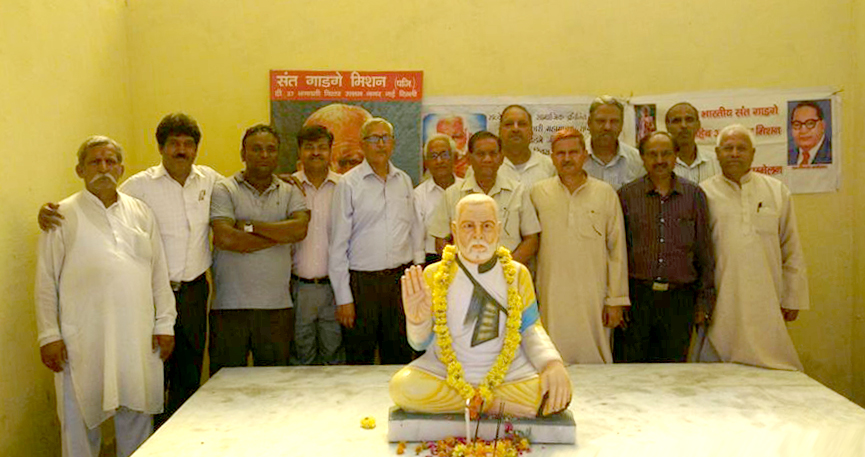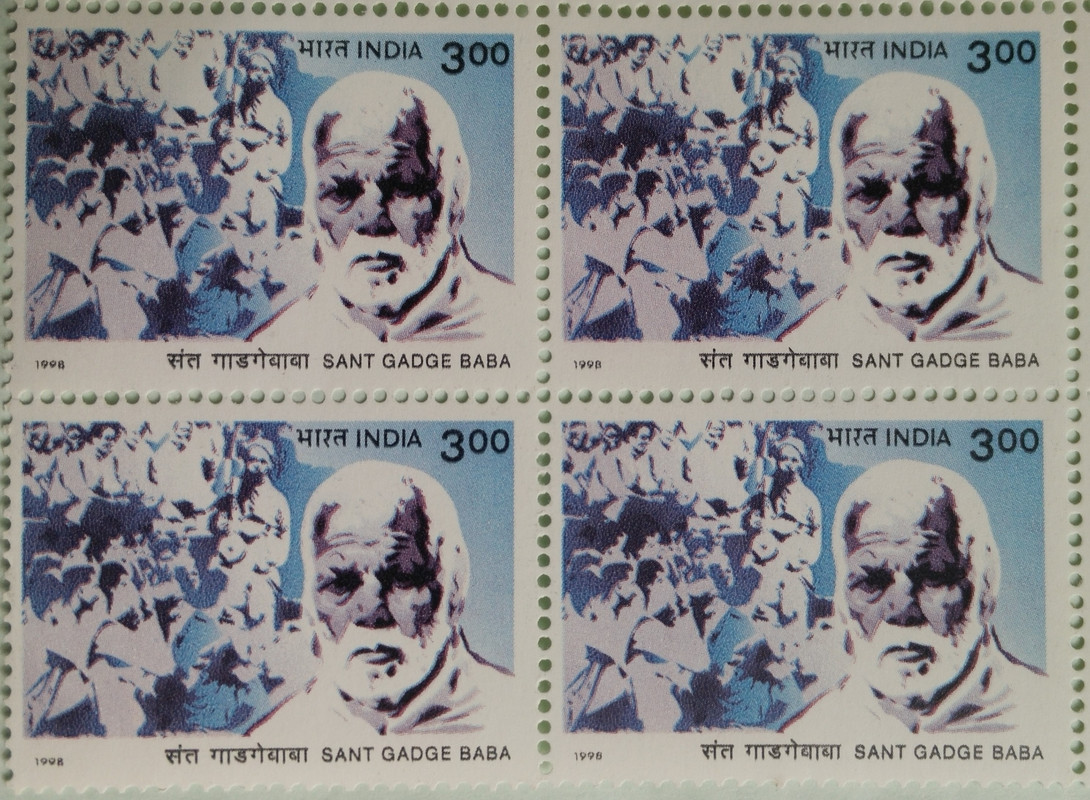 In Delhi with a view to spread the revolutionary social and educational thoughts of Sant Gadge Ji Maharaj among the different societies for social and economic harmony, Sant Gadge Mission was established on 3rd September, 2000, in a meeting under the Chairmanship of Shri C. P. Singh at his residence Shalimar Bagh, New Delhi. An executive Committee was formed on the same day on the name of Sant Gadge Mission. It was registered on 25th April, 2001, under Societies Registration Act XXI of 1860 by Registrar of Societies, Government of NCT of Delhi.
In Delhi with a view to spread the revolutionary social and educational thoughts of Sant Gadge Ji Maharaj among the different societies for social and economic harmony, Sant Gadge Mission was established on 3rd September, 2000, in a meeting under the Chairmanship of Shri C. P. Singh at his residence Shalimar Bagh, New Delhi. An executive Committee was formed on the same day on the name of Sant Gadge Mission. It was registered on 25th April, 2001, under Societies Registration Act XXI of 1860 by Registrar of Societies, Government of NCT of Delhi.
To sustain the abhiyan, we are drawing inspiration from beloved Sant Gadge Maharaj, Manavta ke Pujari, Manav Seva ke liye Samarpit an icon for Swachh Bharat Abhiyan.
What is the most innovative and nationally important development initiative Prime Minister Narendra Modi has launched in his first nine months in office? It is, undoubtedly, the Swachh Bharat mission. No previous prime minister gave such high priority to something as basic as making India clean. The mission has galvanised a large number of people and one hopes the government does not let its momentum slacken.
Every mass campaign needs inspiring icons brand ambassadors, the PM made Mahatma Gandhi, the messenger of the mission. However, one such venerable personality is Sant Gadge Baba (1876-1956) practised the mantra of Clean Outside, Clean Inside: that the government has not attached with the mission. This peripatetic mendicant-saint was from Maharashtra, one of the greatest modern-day social reformers in India, worked for, and among the poorest of the poor. In 2010, the Maharashtra government launched a campaign for clean villages called the “Sant Gadge Baba Gram Swachhata Abhiyan”. For 50 long years, from the time he left his home and family in 1905 for social harmony until his death, he wandered from village to village, from town to town, with a broom in hand, his only other worldly possession being a small earthen pot he used to have to beg for food.
 Baba, an illiterate scholar who did not study in the University, was a preacher par excellence. He sang bhajans composed by Bhakti saints, Sant Tukaram being his favourite. Cleanliness is godliness, he would answer when some people ridiculed him for mixing bhajans with broom-work. The first thing he did after entering a village was to sweep the streets, especially the streets of untouchables quarters, singing songs interspersed with his signature slogan, Gopala! Gopala! Devakinandan Gopala. People would join him and very soon the village would wear a
Baba, an illiterate scholar who did not study in the University, was a preacher par excellence. He sang bhajans composed by Bhakti saints, Sant Tukaram being his favourite. Cleanliness is godliness, he would answer when some people ridiculed him for mixing bhajans with broom-work. The first thing he did after entering a village was to sweep the streets, especially the streets of untouchables quarters, singing songs interspersed with his signature slogan, Gopala! Gopala! Devakinandan Gopala. People would join him and very soon the village would wear a  clean look. Thereafter, usually after a common, contributory meal that people of all castes and communities ate together, he would gather the villagers for an interactive kirtan session of two-three hours at night for inside cleaning and social harmony.
clean look. Thereafter, usually after a common, contributory meal that people of all castes and communities ate together, he would gather the villagers for an interactive kirtan session of two-three hours at night for inside cleaning and social harmony.
His kirtans had a mesmerising and wrong belief-shattering effect on the audience. He would boldly challenge religious orthodoxy and peoples entrenched beliefs and behavioural modes on what constituted cleanliness and impurity, morality and immorality, faith and blind faith. He is at his unorthodox best in his last kirtan, delivered in Mumbai on November 8, 1956, just a month before his death; it is available at https://www.youtube.com/watch?v=9N-5v6eBizw It was organised by police department for social harmony and reforms.
Baba, who was born into the caste of washermen (parit), questioned discrimination based on caste and gender. If God is the Father of all human beings, and if He is kind and all loving, how can He be unkind towards some castes and kind towards others? he would ask, Selfless and compassionate service of those in need is the highest form of religion, he preached. God does not reside in temples, masjids, idols and places of pilgrimage. He resides in the dwellings of the poor and the grief stricken. Free of all metaphysical debates about God, his simple message, delivered in the culturally rich native language of the common people, was that Dharma means food for the hungry, water for the thirsty, clothing for the naked, shelter for the homeless, care for the sick, education for the children of the poor, love and protection for animals and birds, hope for those in despair. Above all, he insisted, dharma means dissolution of the ego, a precondition to experiencing the divinity in humanity.
As behaves any true saint, his deeds matched his words. Like Saint Francis, he lived a life of voluntary poverty of an extreme kind. The clothes he wore was a patchwork of pieces of torn old clothes used by others. He had absolutely no attachment to money or life material comforts. Yet, donors, small and big, poured money into his charitable projects like construction of schools, hostels etc. for general masses. He built numerous dharmshalas, goshalas, schools and hostels for poor students, and homes for destitute children in different parts of Maharashtra by perineal method, “By the People for the People”. This we have forgotten and are facing all types of problems of unemployment, quality of education etc. today.
He fiercely attacked greed, corruption, exploitation through money-lending, alcoholism, superstitions, animal sacrifice as a religious rite and other personal and social ills. Ridiculing godmen who claimed to perform miracles, he would say, Man himself is a great miracles !. Is, injustice in society is also a miracles?. How is it that the farmer, who harvests gold in the form of food from the land, must starve? This, indeed, is the strangest miracle! of dishonesty of Richman. Thus, the holistic ideal of cleanliness he propagated had physical, ethical, spiritual, and social-reformist dimensions. In this, he had much in common with Mahatma Gandhi, Lord Budha, he treated patients of leprosy, a dreaded and stigmatised disease those days. He greatly respected the Mahatma, describing him in his kirtans as a devdoot.
Significantly, Baba was also highly respected by Dr. B.R. Ambedkar. The two met several times. Baba handed over a Dharamshala he had established in the temple town of Pandharpur to Ambedkar for his care. Dr. B.R. Ambedkar converted that dharamshala into hostel for SC/ST students. Once, in 1949, Ambedkar, who was India’s first law minister then, came to know that Baba was unwell in Mumbai. He rushed to see him. Baba told him: Why did you take the trouble of coming? Yours each minute is precious. I am just a fakir. You are the one occupying a position of high authority. Dr. Ambedkar reply is significant, my authority as a minister, Baba, is short-lived. Once the ministership goes, the person has no authority. Your authority as a saint is everlasting.
It is not for nothing that the common people in India reverentially describe saints as maharaj. Thus, Baba is more popularly known as Sant Gadge Maharaj. It is the unique greatness of Indian culture that the words baba and fakir are regarded as synonymous with king, one who continues to rule over the hearts of common people long after his death.
To fallow the Sant Gadge Maharaj achievements for cease-less and compromising efforts to eradicate superstitions, belief in super- natural powers, boon seeking habits etc.
- He complained for the removal of alcohol drinking, wasteful expenditure, dowry, child marriage, etc.
- He denounced casteism, untouchability, exploitation of man by man, exploitation of agricultural labour by peasants and that of the peasants by traders, money lenders and shopkeepers.
- He also opposed the exploitation and ill-treatment of the devotees at the religious places.
- He used to say that the education is must to all.
Other Links about Sant Gadge Maharaj:
https://amravati.gov.in/national-saint/gadge-baba/

